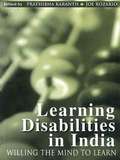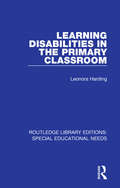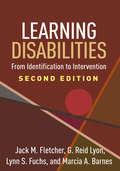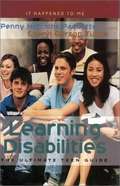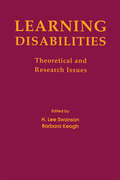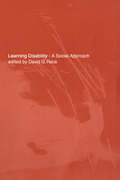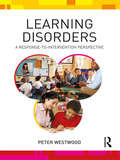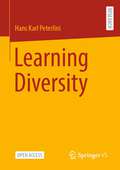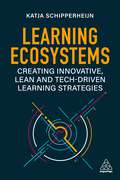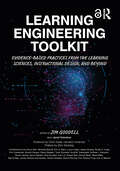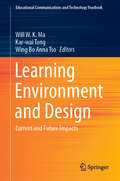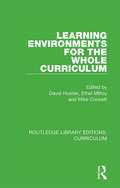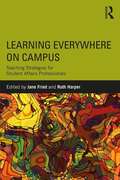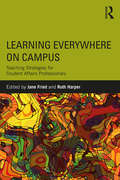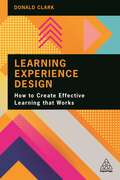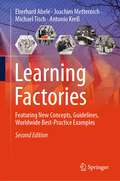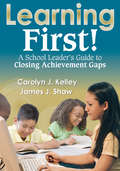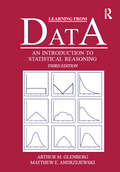- Table View
- List View
Learning Disabilities in India
by Joe Rozario Pratibha KaranthThis important volume, perhaps the first of its kind in India, brings together professionals from diverse fields who share their experiences of tackling the problem of Learning Disabilities (LD) in India. Highlighting the nuances and specificities of learning disabilities and disorders in the Indian context, the contributors cover a wide range of important issues, including: - the neurological, psychiatric and neuropsychological aspects of LD - problems of language and reading acquisition in the bilingual and multilingual situation prevailing in India - issues of identification and assessment - speech and hearing issues, especially central auditory processing disorders and language deficits The contributors also discuss the changing nature of the needs of children with LD, suggest remedies like primary prevention, stress the importance of integrating affected children in mainstream schools and argue for the need to create awareness about learning disorders.
Learning Disabilities in the Primary Classroom (Routledge Library Editions: Special Educational Needs #30)
by Leonora HardingFirst published in 1986. This book is concerned with the problems children have in learning in normal or remedial classrooms, within ordinary primary schools. It deals with children in the 5 to 11 age range but much is also applicable to children at the lower end of the secondary school. It looks at a wide range of difficulties and for each area it classifies and describes the difficulties, considers the numbers of children with the difficulty; and discusses problems of diagnosis and remediation. It reviews certain psychological theories and research findings and relates them to practice; and it describes the work of professionals such as speech therapists, showing how the classroom teacher can support such professionals; but the major concern of the book is to help practicing teachers and teachers in training to work out intelligently for themselves how to improve their performance in this area.
Learning Disabilities, Second Edition: From Identification to Intervention
by Marcia A. Barnes G. Reid Lyon Jack M. Fletcher Lynn S. FuchsReviewing the state of the science of learning disabilities (LDs) and describing effective educational practices, this authoritative volume has been significantly revised and expanded with more than 70% new material. Foremost LD experts identify effective principles of assessment and instruction within the framework of multi-tiered systems of support (MTSS). With a focus on what works in the classroom, the book explores the full range of reading, mathematics, and writing disabilities. It synthesizes knowledge from neuropsychology, cognitive neuroscience, and special and general education. Illustrations include eight color plates. As a special supplement, a chapter on the history of the LD field from the first edition is provided at the companion website. New to This Edition *Heightened emphasis on intervention, including significant new developments in reading comprehension and math. *Reflects major scientific advances in understanding LDs. *Chapter on principles of effective instruction and MTSS. *Chapter on automaticity in reading, math, and writing. *Chapter on challenges in real-world implementation of evidence-based practices. *Chapter on the validity of the LD construct.
Learning Disabilities: Educational Principles and Practices
by Doris J. Johnson Helmer R. MyklebustFocuses on practical solutions to educational problems involving spoken language, reading, writing, arithmetic, & nonverbal disorders, making this book a timeless reference for all who desire a thorough understanding of learning.
Learning Disabilities: The Ultimate Teen Guide
by Penny Hutchins Paquette Cheryl Gerson TuttleWritten for adolescents confronting learning disabilities, this book provides an overview of the most common disabilities and offers advice on overcoming the difficulties associated with them. Medical aspects of the disabilities are covered and celebrities with similar conditions are profiled. Assistive technology is described, and advice is offered concerning advocacy. Paquette is an educational writer; Tuttle is a special education coordinator. Annotation (c)2003 Book News, Inc., Portland, OR (booknews.com)
Learning Disabilities: Theoretical and Research Issues
by H. Lee Swanson Barbara KeoghThis volume has been developed as a direct result of a conference sponsored by the International Academy for Research in Learning Disabilities, held at the University of California at Los Angeles. The text provides a review and critique of current research in the areas of intelligence, social cognition, achievement, and subtyping as they relate to learning disabilities. In addition, the concept that social behavior is an aspect of intelligence and the relationship between language and reading are discussed in detail by noted experts.
Learning Disability: A Social approach
by David G. RaceThe detailed study of learning disability features rarely in university courses. To a large extent this reflects the low value attributed by our society and its human services to people with learning difficulties. This unusual book, based on one of those rare courses, includes contributions from academic specialists, students and people with learning difficulties, all of whom have participated in the course. Its 'social approach' challenges the very idea of what should be taught about the subject of learning disability and who should teach it. Learning Disability - A Social Approach looks at how people's lives are affected by human services. It covers specific policy and service issues, different aspects of working with people and key debates. The unique insights gained from the combination of academic knowledge and real life experience make it a topical and thought-provoking text for anyone involved with learning disability - student, teacher, professional or policy maker.
Learning Disorders: A Response-to-Intervention Perspective
by Peter WestwoodWhat are learning disorders? How can schools endeavour to address these disorders in today’s inclusive classrooms? This book answers these important questions in practical terms and discusses in detail the instructional needs of students with dyslexia, dysgraphia, dyscalculia, dyspraxia and other significant disorders that affect learning. Peter Westwood draws on international research literature to provide supporting evidence of best practices. The book is unique in linking the teaching methods recommended for overcoming learning problems directly to each of the three tiers of support in the Response-to-Intervention Model. It presents examples of effective whole-class teaching, intensive small group instruction and individual tutoring, as well as addressing key topics such as: educational progress of students with learning disorders; principles for teaching dyslexic students; difficulties with writing and spelling; developing students’ numeracy skills; specific intervention strategies; nonverbal learning disabilities. Learning Disorders will be of interest to practising teachers, trainee teachers, teaching assistants, educational psychologists, school counsellors and parents. It will also provide valuable insights for any school planning to upgrade its support system for students with special educational needs.
Learning Diversity
by Hans Karl PeterliniThis Open-Access-book explores diversity in its ambivalence. On the one side, we love to describe diversity as a resource for personal, social, economic, and cultural growth. On the other side, categories of differences often lead to discrimination or serve as justifications for privileges. They can cause exclusion and, conversely, promote the self-constitution of discriminated subjects and groups.The book moves within this tension of exclusion and belonging. Case studies of young ethnicized people vividly depict the interwovenness of identity-building and diversity. Theoretically, the book examines the psychosocial and anthropological conditions for constructing the Other. Sharp divisions between We and the Other, between social and national groups, and between humans and nature have devastating, life-threatening consequences. Dichotomous split-offs divide people, nations and the whole world. So, how do we deal with diversity? The author does not provide simple recipes but engages in a phenomenology of diversity that does not press life and its manifestations into categories but keeps them in a limbo of attention by affirming and doubting differences.
Learning Ecosystems: Creating Innovative, Lean and Tech-driven Learning Strategies
by Katja SchipperheijnBuilding and sustaining an organization which is nimble, adaptable, resilient and future proof is both complex and urgent. Only those with flexible and innovative Learnscapes will succeed.Learning Ecosystems explains how organizations evolve into LearnScapes where learning techniques are aligned with continuous interaction with the ecosystem they are part of. It explains how to upskill and reskill a workforce continuously in an increasingly collaborative and tech-enabled world. Full of practical guidance and strategic advice, this book covers how to take a lifelong approach to learning in the organization and the core competencies needed for this. It explains what to do when building a value and data-driven learning strategy and discusses the symbiosis of people and technology. This book explores lean learning, data analytics, learning technologies including artificial intelligence (AI) and the ethics of using these technologies. There is also crucial guidance on how to take a human-centric approach to innovation. Learning Ecosystems demonstrates the value of continuous improvement and offers techniques for a variety of situations including problem analyses, experimentation and algorithmic business thinking. Most importantly, it provides guidance on how to build a learning culture and a learning ecosystem throughout the company. Supported by case studies from companies including Etihad Airways, ING, ESF and FEDEX, this is essential reading from a leading learning innovator who has helped global organizations to rethink their learning strategies to achieve sustained business growth.
Learning Engineering Toolkit: Evidence-Based Practices from the Learning Sciences, Instructional Design, and Beyond
by Janet Kolodner Jim GoodellThe Learning Engineering Toolkit is a practical guide to the rich and varied applications of learning engineering, a rigorous and fast-emerging discipline that synthesizes the learning sciences, instructional design, engineering design, and other methodologies to support learners. As learning engineering becomes an increasingly formalized discipline and practice, new insights and tools are needed to help education, training, design, and data analytics professionals iteratively develop, test, and improve complex systems for engaging and effective learning. Written in a colloquial style and full of collaborative, actionable strategies, this book explores the essential foundations, approaches, and real-world challenges inherent to ensuring participatory, data-driven, learning experiences across populations and contexts.
Learning Engineering Toolkit: Evidence-Based Practices from the Learning Sciences, Instructional Design, and Beyond
by Janet Kolodner Jim GoodellThe Learning Engineering Toolkit is a practical guide to the rich and varied applications of learning engineering, a rigorous and fast-emerging discipline that synthesizes the learning sciences, instructional design, engineering design, and other methodologies to support learners. As learning engineering becomes an increasingly formalized discipline and practice, new insights and tools are needed to help education, training, design, and data analytics professionals iteratively develop, test, and improve complex systems for engaging and effective learning. Written in a colloquial style and full of collaborative, actionable strategies, this book explores the essential foundations, approaches, and real-world challenges inherent to ensuring participatory, data-driven, learning experiences across populations and contexts."Introduction: What Is Learning Engineering?", "Chapter 1: Learning Engineering is a Process", and "Chapter 2: Learning Engineering Applies the Learning Sciences" are freely available as downloadable Open Access PDFs at http://www.taylorfrancis.com under a Creative Commons Attribution-Non Commercial-No Derivatives (CC-BY-NC-ND) 4.0 license.
Learning Engineering for Online Education: Theoretical Contexts and Design-Based Examples
by Chris Dede John Richards Bror SaxbergLearning Engineering for Online Education is a comprehensive overview of the emerging field of learning engineering, a form of educational optimization driven by analytics, design-based research, and fast-paced, large-scale experimentation. Chapters written by instructional design and distance learning innovators explore the theoretical context of learning engineering and provide design-based examples from top educational institutions. Concluding with an agenda for future research, this volume is essential for those interested in using data and high-quality outcome evidence to improve student engagement, instructional efficacy, and results in online and blended settings.
Learning Environment and Design: Current and Future Impacts (Educational Communications and Technology Yearbook)
by Wing Bo Anna Tso Will W. K. Ma Kar-Wai TongThis special edition of the Educational Communications and Technology Yearbook Series bears a title of “Learning Environment and Design: Current and Future Impact”. It provides a timely forum to share theoretical and practical insights in both the local and international contexts in response to the fact that new media and technologies have infiltrated and shaped the learning environments from mere physical spaces into multifaceted possibilities, impacting the ways individuals teach and learn. Designs of learning environments to harness technologies appropriately to engage learners better, as well as the roles of learners and educators play in this changing learning environment, are examples of important global issues in the discourse of the contemporary educational developments. Having gathered a diverse collection of research papers written by scholars and practitioners in the fields of education, communication and humanities across Asia, Australasia, Europe and the United States, this book gives readers a cross-cultural background on the developments of technological designs and educational practices, investigating areas in redefining of quality education; online learning and blended learning; new media in education; gamification, AI, and innovative learning technologies. Aimed to catalyze knowledge exchanges and provide fresh views on interdisciplinary research, the book sheds light on how emerging technologies can be adapted in the fields of education and communication, so as to facilitate the current and future designs of learning environments to improve learners’ performances.
Learning Environments for the Whole Curriculum (Routledge Library Editions: Curriculum #19)
by David Hustler Ethel Milroy Mike CockettOriginally published in 1991. Consisting of 18 teachers' reports on attempts to change traditional learning environments, the contributors argue for a commitment to whole curriculum planning, which embraces a variety of learning environments both inside and outside the school walls. There is a particular concern in several of the reports for lower attaining pupils and those pupils who seem to gain very little from `normal lessons'.
Learning Everywhere On Campus: Teaching Strategies For Student Affairs Professionals
by Jane Fried Ruth HarperAlthough student affairs practitioners play a key role in student learning, few are familiar with learning theories, the design of experiential education, or pedagogical theory. This edited collection describes programs in which student affairs professionals work independently or in collaboration with academic faculty and community partners to create more intentional and consistent approaches that enhance student learning. Examples, models, and case studies throughout the chapters make the theories and ideas specific and practical. Exploring educational opportunities in and outside the classroom, such as peer education, leadership development, life and career planning, civic engagement, service-learning, and study abroad, this book provides both theories and pedagogical frameworks for organizing and integrating the entire institution to promote and support learning. Drawing on multiple perspectives, Learning Everywhere on Campus shares the interventions and strategies necessary to help students learn new information, acquire skills, and understand the value of this knowledge in constructing their sense of purpose and self in the world.
Learning Everywhere on Campus: Teaching Strategies for Student Affairs Professionals
by Jane Fried Ruth HarperAlthough student affairs practitioners play a key role in student learning, few are familiar with learning theories, the design of experiential education, or pedagogical theory. This edited collection describes programs in which student affairs professionals work independently or in collaboration with academic faculty and community partners to create more intentional and consistent approaches that enhance student learning. Examples, models, and case studies throughout the chapters make the theories and ideas specific and practical. Exploring educational opportunities in and outside the classroom, such as peer education, leadership development, life and career planning, civic engagement, service-learning, and study abroad, this book provides both theories and pedagogical frameworks for organizing and integrating the entire institution to promote and support learning. Drawing on multiple perspectives, Learning Everywhere on Campus shares the interventions and strategies necessary to help students learn new information, acquire skills, and understand the value of this knowledge in constructing their sense of purpose and self in the world.
Learning Experience Design: How to Create Effective Learning that Works
by Donald ClarkHow can I create in-person learning that engages people? How can I build digital learning that is effective? How can I develop learning content that can be used remotely and ensure that the learning sticks? Learning Experience Design has the answers to all these questions and more. This book is a practical guide for all learning and development (L&D) professionals. It covers everything from what learning experience design (LXD) is, the role of the L&D professional in LXD, and what the main areas to consider when designing learning are including emotion, attention, memory, engagement, enjoyment, transfer, practice and learning retention. It includes practical advice for all areas of learning design including text, graphics, audio, visual, simulations, AR/VR, question and social design. There is also essential guidance on instructional design, UX (user experience) design and how to design effective learning analytics. The final part of the book covers design thinking, blended learning and discussion of LMSs (learning management systems), LXPs (learning experience platforms) and LRSs (learning record stores). With examples, tips, case studies and advice throughout, this is an invaluable book for anyone wanting to make an impact with their learning design and ensure knowledge, skills and performance improvement.
Learning Factories: Featuring New Concepts, Guidelines, Worldwide Best-Practice Examples
by Eberhard Abele Joachim Metternich Michael Tisch Antonio KreßThis book presents the state of the art of learning factories. It outlines the motivations, historic background, and the didactic foundations of learning factories. Definitions of the term learning factory and an updated morphological model are provided as well as a detailed overview of existing learning factory approaches in industry and academia, showing the broad range of different applications and varying contents in all continents. International learning factory best-practice examples are presented in detailed and structured manner. The state of the art of learning factories curricula design and their use to enhance learning and research as well as potentials and limitations are presented. Further research priorities and innovative learning factory concepts to overcome current barriers are offered. While today numerous learning factories have been built in industry (big automotive companies, pharma companies, etc.) and academia in the last decades, a comprehensive handbook for the scientific community and practitioners alike is still missing. The book addresses therefore both researchers in production-related areas that want to conduct industry-relevant research and education, as well as managers and engineers in industry, who are searching for an effective way to train their employees. In addition to this, the learning factory concept is also regarded as an innovative learning concept in the field of didactics.
Learning First!: A School Leader's Guide to Closing Achievement Gaps
by Dr Carolyn J Kelley James J. ShawCombine this research-based, collaborative framework with four critical dimensions of leadership to advance equity and excellence in student learning and close student achievement gaps in your school.
Learning First, Technology Second: The Educator's Guide to Designing Authentic Lessons
by Liz KolbLearning with technology does not happen because a specific tool “revolutionizes” education. It happens when proven teaching strategies intersect with technology tools, and yet it is not uncommon for teachers to use a tool because it is “fun” or because the developer promises it will help students learn. <p><p> Learning First, Technology Second offers teachers the professional learning they need to move from arbitrary uses of technology in their classrooms to thoughtful ways of adding value to student learning. <p> This book includes: an introduction to the Triple E Framework that helps teachers engage students in time-on-task learning, enhance learning experiences beyond traditional means and extend learning opportunities to bridge classroom learning with students’ everyday lives; effective strategies for using technology to create authentic learning experiences for their students; case studies to guide appropriate tech integration; and a lesson planning template to show teachers how to effectively frame technology choices and apply them in instruction.
Learning From Children Who Read at an Early Age
by Rhona Stainthorp Diana HughesLearning From Children Who Read at an Early Age is the result of a three-year research project in which the authors studied a group of children who learnt to read without being taught, from before they started school until the end of Year 2 when they were given their first National Curriculum assessments.Using this study as a framework for examining how children make progress over their time in Key Stage 1 across a range of literacy skills, the authors suggest guidelines which teachers can use to help all children progress with reading.
Learning From Data: An Introduction To Statistical Reasoning
by Arthur Glenberg Matthew AndrzejewskiLearning from Data focuses on how to interpret psychological data and statistical results. The authors review the basics of statistical reasoning to helpstudents better understand relevant data that affecttheir everyday lives. Numerous examples based on current research and events are featured throughout.To facilitate learning, authors Glenberg and Andrzejewski: Devote extra attention to explaining the more difficult concepts and the logic behind them Use repetition to enhance students’ memories with multiple examples, reintroductions of the major concepts, and a focus on these concepts in the problems Employ a six-step procedure for describing all statistical tests from the simplest to the most complex Provide end-of-chapter tables to summarize the hypothesis testing procedures introduced Emphasizes how to choose the best procedure in the examples, problems and endpapers Focus on power with a separate chapter and power analyses procedures in each chapter Provide detailed explanations of factorial designs, interactions, and ANOVA to help students understand the statistics used in professional journal articles. The third edition has a user-friendly approach: Designed to be used seamlessly with Excel, all of the in-text analyses are conducted in Excel, while the book’s CD contains files for conducting analyses in Excel, as well as text files that can be analyzed in SPSS, SAS, and Systat Two large, real data sets integrated throughout illustrate important concepts Many new end-of-chapter problems (definitions, computational, and reasoning) and many more on the companion CD Online Instructor’s Resources includes answers to all the exercises in the book and multiple-choice test questions with answers Boxed media reports illustrate key concepts and their relevance to realworld issues The inclusion of effect size in all discussions of power accurately reflects the contemporary issues of power, effect size, and significance. Learning From Data, Third Edition is intended as a text for undergraduate or beginning graduate statistics courses in psychology, education, and other applied social and health sciences.
Learning From Data: An Introduction to Statistical Reasoning using JASP
by Arthur M. Glenberg Matthew E. AndrzejewskiThis fully updated fourth edition explores the foundations of statistical reasoning, focusing on how to interpret psychological data and statistical results. This edition includes three important new features. First, the book is closely integrated with the free statistical analysis program JASP. Thus, students learn how to use JASP to help with tasks such as constructing grouped frequency distributions, making violin plots, conducting inferential statistical tests, and creating confidence intervals. Second, reflecting the growing use of Bayesian analyses in the professional literature, this edition includes a chapter with an introduction to Bayesian statistics (also using JASP). Third, the revised text incorporates adjunct questions, that is, questions that challenge the student’s understanding, after each major section. Cognitive psychology has demonstrated how adjunct questions and related techniques such as self-explanation can greatly improve comprehension.Additional key features of the book include:• A user-friendly approach, with focused attention to explaining the more difficult concepts and the logic behind them. End of chapter tables summarize the hypothesis testing procedures introduced, and exercises support information recall and application.• The consistent use of a six-step procedure for all hypothesis tests that captures the logic of statistical inference.• Multiple examples of each of the major inferential statistical tests.• Boxed media reports illustrate key concepts and their relevance to real-world issues.• A focus on power, with a separate chapter, and power analysis procedures in each chapter.With comprehensive digital resources, including large data sets integrated throughout the textbook, and files for conducting analysis in JASP, this is an essential text for undergraduate or beginning graduate statistics courses in psychology, education, and other applied social and health sciences.
Learning From Mistakes In Clinical Practice
by Carolyn DillonThis text is a virtual handbook of classic mistakes to anticipate, work through, and grow from. It identifies, discusses and re-frames classic mistakes that beginning interviewers and clinicians are likely to make in practice by illuminating a myriad of mistakes through the use of first-hand vignettes, in-text exercises, and a systems framework. This book uses a strengths-perspective, and can serve as a companion text or as a stand-alone primer because of its elaboration of the phases, principles, strategies and methods used in the helping process.
